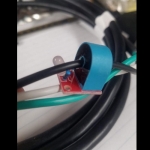I had a situation where I wanted to know if current was flowing to a device. I have a block heater on the tractor and if I plug it in, how do I know that it is operating? I could wait a while and see if it warms up, but it would be nicer if I could tell immediately that current is flowing.
Just putting an indicator light on the end plug doesn't tell me the heater is running (my plug from the block heater might have failed). I could get a clamp on amp meter and set that up or I could put an amp meter on one of the outlets in the tractor shed which would be dedicated to the block heater or perhaps there was another way - using stuff I already had.
Turns out, I had a similar problem as I had a pump that I needed to monitor and if the pump stopped running (for whatever reason) I needed to raise an alarm so that yours truly could intervene. For that, I designed a circuit using a current transformer that looks like this:
Vdd is 5v and GND is NOT attached to earth.
That circuit works really well and can sense the current flowing when the power was down to less than a watt and up to many hundreds of watts (the pump was a variable speed pump).
For the tractor, I wanted to make it simpler and I came up with this:
Pretty simple - 5A/5mA Current Transformer, LED, and Resistor...
When I bought the current transformer for the pump, at the time it came with a circuit board and you got two sets in the package. You could use the circuit board (I cut in the resistor), but you could also wire it up on a breadboard or even just to the leads of the components.
The current transformer is an AC device so it's output is AC as well. The HOT line (BLACK in the USA) goes through the hole in the current transformer and the rest of the components are isolated from the line voltage. Most of these current transformers have isolation voltage ratings of thousands of volts (I think mine are 4500V). The orientation of the LED doesn't matter, since it is AC. I put the resistor in there to limit the current in the current transformer and the LED. The value you see is what works well for my block heater. In your case, start higher and lower the value of the resistor until it is bright enough to see the LED. I used an LED that was in my "inventory" (I have no clue of it's specs, it was red and I fussed with the resistor value to get it visible).
Here is what it looks like when built:
the back of the board
the front of the board
closer view of the front
The current transformer I used was a ZTA503C, but just about any 5A/5mA (1000:1) ratio transformer will do. I think a part number I've seen recently is ZMCT103C. Remember you are using a current limiting resistor, so you don't need to scale up to a larger current transformer. There is one on amazon - 10 pieces for $8, another 5 pieces with circuit board for $7. That newer part number shows up on aliexpress as well and pretty cheap.



 LinkBack URL
LinkBack URL About LinkBacks
About LinkBacks







 Reply With Quote
Reply With Quote



Bookmarks